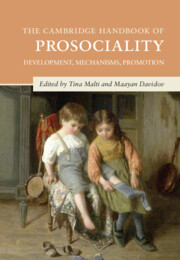Book contents
- The Cambridge Handbook of Prosociality
- Cambridge Handbooks in Psychology
- The Cambridge Handbook of Prosociality
- Copyright page
- Dedication
- Contents
- Figures
- Contributors
- Part I Development of Prosociality
- Part II Antecedents and Mechanisms of Prosociality
- Part III Development of Prosociality in Context
- 18 Parenting and Children’s Prosociality
- 19 Sibling Influences on Prosociality
- 20 Prosocial Behavior, Peer Relationships, and Friendships
- 21 Children’s Intergroup Prosocial Behavior
- 22 Prosocial Behavior in School Contexts
- 23 Community and Neighborhood Influences on Prosociality in Children and Youth
- 24 Culture and Prosociality
- 25 Prosocial Media
- Part IV Applications
- Index
- References
22 - Prosocial Behavior in School Contexts
from Part III - Development of Prosociality in Context
Published online by Cambridge University Press: 25 May 2023
- The Cambridge Handbook of Prosociality
- Cambridge Handbooks in Psychology
- The Cambridge Handbook of Prosociality
- Copyright page
- Dedication
- Contents
- Figures
- Contributors
- Part I Development of Prosociality
- Part II Antecedents and Mechanisms of Prosociality
- Part III Development of Prosociality in Context
- 18 Parenting and Children’s Prosociality
- 19 Sibling Influences on Prosociality
- 20 Prosocial Behavior, Peer Relationships, and Friendships
- 21 Children’s Intergroup Prosocial Behavior
- 22 Prosocial Behavior in School Contexts
- 23 Community and Neighborhood Influences on Prosociality in Children and Youth
- 24 Culture and Prosociality
- 25 Prosocial Media
- Part IV Applications
- Index
- References
Summary
Schooling transforms child development yet fades into the background in research on prosocial behavior. Mass education, however, was central to the concerns of founding theorists such as Durkheim, Dewey, and Piaget. Putting on a sociological lens makes it easier to see how schools continue to play an active role in prosocial development, and how the concerns of these founding researchers resonate today. To situate the active role of school contexts in prosocial behavior, this chapter first examines schools as social systems, structuring children’s social networks, imposing roles and norms of behavior, and impacting the timing of development. The chapter then examines classroom, pedagogical, and peer prosocial behaviors, and their connection to classic theoretical work in the field. After reviewing these forms of prosocial behavior, the chapter closes by examining the links between prosocial behavior and student outcomes and implications and future directions for theory, research, and practice.
- Type
- Chapter
- Information
- The Cambridge Handbook of ProsocialityDevelopment, Mechanisms, Promotion, pp. 442 - 458Publisher: Cambridge University PressPrint publication year: 2023
References
- 1
- Cited by



